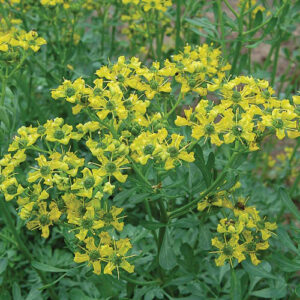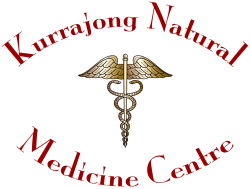Medicinal Herb: Rue (Ruta graveolens)
Rue (Ruta graveolens)
Biological Name:
(Ruta graveolens)
Family:
Rutaceae
Other Names:
Rue, Common rue, garden rue, German rue, herb-of-grace, countryman’s treacle, herbygrass
Aruta, Garden Rue, Somalata, Sadab

Introduction:
Rue is an aromatic perennial plant native to southern Europe and northern Africa and commonly cultivated in Europe and the U.S., sometimes escaping to grow wild locally. The branched, pale green, glabrous stem bears alternate, pinnately compound, somewhat fleshy leaves with oblong to spatulate leaflets. Small yellow or yellow-green flowers appear from June to August.
The stem is woody in the lower part, the leaves are alternate, bluish-green, bi- or tripinnate, emit a powerful, disagreeable odour and have an exceedingly bitter, acrid and nauseating taste.
The greenish-yellow flowers are in terminal panicles, blossoming from June to September. In England R. graveolens is one of our oldest garden plants, cultivated for its use medicinally, having, together with other herbs, been introduced by the Romans, but it is not found in a wild state except rarely on the hills of Lancashire and Yorkshire. This wild form is even more vehement in smell than the garden Rue. The whole plant has a disagreeable and powerful odour. The first flower that opens has usually ten stamens, the others eight only.
Active Compounds:
Volatile oil, 2-undecanone (50-90%), 2-haptanol, 2-nonanol, 2-nonanone, limonene, pinene, anisic acid, phenol, guiacol and others.
Flavonoids such as quercitin and rutin
Coumarins: bergapten, daphnoretin, isoimperatorin, naphthoherniarin, psoralen, pangelin, rutamarin, rutarin, scopoletin and umbelliferone
Alkaloids: arborinine, g-fagarine, graveoline, graveolinine, kokusaginine, rutacridine.
Lignans, in the root; savinin and helioxanthin.
Scientific Evidence:
Antibacterial/Antifungal activity
More than 15 compounds in rue have been identified as having in vitro antibacterial and antifungal activity. The acridone alkaloids are the most potent antimicrobial compounds; the coumarins inhibit growth only at high doses. The essential oil and flavonoids tested did not show activity. One report suggests that extracts of R. graveolens demonstrated inhibitory effects against gram positive organisms such as Staphylococcus aureus, Streptococcus pyogenes, Listeria monocytogenes, and Bacillus subtilis.
Other researchers have found that a number of components of rue interfere directly with DNA replication, thereby preventing the propagation of some viruses.
The leaf of R. graveolents is said to alleviate cancer of the mouth, as well as tumors and warts. In Chinese medicine, rue is used as a vermifuge and for insect bites.
Experimentation in H. pylori-infected gastric epithelial cells with 24 medicinal plants indigenous to Pakistan was conducted to evaluate their effect on secretion of interleukin (IL)-8 and generation of reactive oxygen species (ROS) in order to assess anti-inflammatory and cytoprotective effects. Although no significant direct cytotoxic effects on the gastric cells or bactericidal effects on H. pylori were found, leaf extract of rue was observed to have moderate and strong inhibitory activity on IL-8 at 50 and 100 mcg/mL, respectively, in H. pylori-infected gastric cells[1].
Traditional Applications in Herbal Medicine:
Abortificient, anthelmintic, antiseptic, antispasmodic, carminative, emmenagogue, irritant, stimulant, stomachic
It is an effective medicine in the treatment of coughs, croup, colic and flatulence. The oil may be given on sugar, or in hot water.
Externally, R. graveolens is an active irritant, being employed as a rubefacient. If bruised and applied, the leaves will ease the severe pain of sciatica. The expressed juice, in small quantities, was a noted remedy for nervous nightmare, and the fresh leaves applied to the temples are said to relieve headache. Compresses saturated with a strong decoction of the plant, when applied to the chest, have been used beneficially for chronic bronchitis.
If a leaf or two be chewed, a refreshing aromatic flavour will pervade the mouth and any nervous headache, giddiness, hysterical spasm, or palpitation will be quickly relieved.
The main uses for R. graveolens are to relieve gouty and rheumatic pains and to treat nervous heart problems, such as palpitations In women going through menopause. The infusion is also said to be useful in eliminating worms.
In European folk medicine, rue serves to relieve gas pains and colic, improve appetite and digestion, and promote the onset of menstruation. Ruta graveolens can also be made into an ointment for external use against gout, rheumatism, and sciatica.
Jethro Kloss recommends the herb for painful menstruation, stomach trouble, cramps in the bowels, nervousness, hysteria, spasms, convulsions, pain in the head, confusion, dizziness, colic and convulsions in children, sciatica, pain in the joints and gout. It is also believed to resist poison.
The herb, on distillation, yields a volatile oil that has many medicinal applications. The internal administration of the oil causes abortion in pregnant women.
References
- https://www.drugs.com/npp/rue.html
- Nahar, L., El-Seedi, H. R., Khalifa, S., Mohammadhosseini, M., & Sarker, S. D. (2021). Ruta Essential Oils: Composition and Bioactivities. Molecules (Basel, Switzerland), 26(16), 4766. https://doi.org/10.3390/molecules26164766
Disclaimer
Disclaimer information for users of the Kurrajong Natural Medicine Centre, Namaste Yoga Kurrajong and The Herbal Health Coach website.
Page last updated: 26th June 2020
Information provided for education and research information only
The information on this website is presented by Kurrajong Natural Medicine Centre for the purpose of disseminating health information free of charge for the benefit of the public.
While Kurrajong Natural Medicine Centre has exercised due care in ensuring the accuracy of the material contained on this website, the information on the site is made available on the basis that Kurrajong Natural Medicine Centre is not providing professional advice on a particular matter.
This website is not a substitute for independent professional advice. Nothing contained in this site is intended to be used as medical advice and it is not intended to be used to diagnose, treat, cure or prevent any disease, nor should it be used for therapeutic purposes or as a substitute for your own health professional’s advice.
Kurrajong Natural Medicine Centre does not accept any liability for any injury, loss or damage incurred by use of or reliance on the information provided on this website.
Quality of information
Kurrajong Natural Medicine Centre makes every effort to ensure the quality of the information available on this website and updates the information regularly. Before relying on the information on this site, however, users should carefully evaluate its accuracy, currency, completeness and relevance for their purposes, and should obtain any appropriate professional advice relevant to their particular circumstances. Kurrajong Natural Medicine Centre cannot guarantee and assumes no legal liability or responsibility for the accuracy, currency, completeness or interpretation of the information.
The material may include the views or recommendations of third parties and does not necessarily reflect the views of Kurrajong Natural Medicine Centre or indicate a commitment to a particular course of action.
Links to other websites
This website contains links to other websites which are external to Kurrajong Natural Medicine Centre. Kurrajong Natural Medicine Centre takes reasonable care in selecting linking websites but Kurrajong Natural Medicine Centre accepts no responsibility for material contained in a website that is linked to this site. It is the responsibility of the user to make their own decisions about the accuracy, currency, reliability and correctness of information contained in linked external websites.
Links to external websites are provided for the user’s convenience and do not constitute an endorsement or a recommendation of any third party products or services offered by virtue of any information, material or content linked from or to this site. Users of links provided by this site are responsible for being aware of which organisation is hosting the site they visit.
Views or recommendations provided in linked sites may include the views or recommendations of third parties and do not necessarily reflect those of Kurrajong Natural Medicine Centre or indicate a commitment to a particular course of action. .



